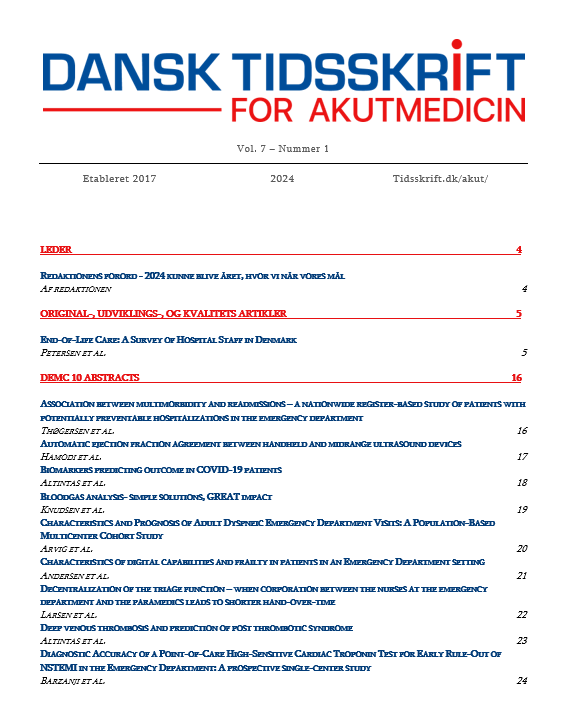Resumé
Background: Many patients want to die at home, but do not get their wishes fulfilled. To combat this, it is important to understand the challenges that stand in the way of healthcare professionals providing quality end-of-life care (EOL) in the patient’s own home.
Aim: The aims of this study were to 1) determine if staff at Emergency Departments experienced significant challenges related to EOL care, 2) how often this led to unnecessary hospital admissions, and 3) if a new “Acute Palliation Kit” (APK) might alleviate some of the challenges identified above.
Methods: This was a cross-sectional survey among doctors (n=53) and nurses (n=74) working in Departments of Emergency Medicine or General Practice in the North Denmark Region. The questionnaire covered the healthcare professionals’ backgrounds, their perceptions of current challenges in EOL care, and the potential effects of the APK.
Results: Among the healthcare professionals, 53% of responders found the most challenging aspect of EOL care to be “Logistic Issues” and 21% “Time consumption”. Out of the responders, 64% had sometimes, often, or always felt the need to admit/maintain admission/push to admit a dying patient, because it was too challenging to start the EOL care at home. On the potential effect of APK, 74% thought it would save time. In addition, most responders thought it would give both the patient and their next of kins better EOL care.
Conclusion: This study showed that doctors and nurses in Departments of Emergency Medicine found discharging patients to EOL care at home challenging mainly due to logistic problems leading to hospital admissions. This was often contrary to the patient’s wishes and takes time and resources from the healthcare professionals. In the future, logistics of EOL care must be simplified if fewer patients are to be admitted to die. A pre-packed EOL care kit might reduce logistics but needs evaluation in dedicated studies.
Referencer
References
WHO. Palliative care [Internet]. [cited 2023 Mar 13]. Available from: https://www.who.int/health-topics/palliative-care
Sundhedsstyrelsen. Calculations based on data from Sundhedsdatastyrelsen. Dødsfald fordelt på dødssted og region 2012-2021 [Internet]. [cited 2023 Mar 15]. Available from: https://sundhedsdatastyrelsen.dk/da/find-tal-og-analyser/tal-og-analyser/doedsaarsager
Brogaard T, Neergaard MA, Sokolowski I, Olesen F, Jensen AB. Congruence between preferred and actual place of care and death among Danish cancer patients. Palliat Med. 2013 Feb;27(2):155–64. : DOI:10.1177/0269216312438468/FORMAT/EPUB
Shepperd S, Goncalves-Bradley DC, E. Straus S, Wee B. Cochrane Library Cochrane Database of Systematic Reviews Hospital at home: home-based end-of-life care (Review). 2021 [cited 2023 Mar 13]; Available from: www.cochranelibrary.com: DOI:10.1002/14651858.CD009231.pub3
Neergaard MA, Larsen H. Palliativ Medicin - en lærebog. 1st ed. Munksgaard; 2015.
Neergaard MA, Olesen F, Bonde Jensen A, Sondergaard J. Palliative care for cancer patients in a primary health care setting: Bereaved relatives’ experience, a qualitative group interview study. 2008 [cited 2023 Mar 23]; Available from: http://www.biomedcentral.com/1472-684X/7/1: DOI:10.1186/1472-684X-7-1
Vejlgaard T, Addington-Hall JM. Attitudes of Danish doctors and nurses to palliative and terminal care. Palliat Med [Internet]. 2005 Mar 1 [cited 2023 Mar 13];19(2):119–27. Available from: https://journals.sagepub.com/doi/10.1191/0269216305pm988oa: DOI:10.1191/0269216305PM988OA
Henriksen DP, Rasmussen L, Hansen MR, Hallas J, Pottegård A. Comparison of the Five Danish Regions Regarding Demographic Characteristics, Healthcare Utilization, and Medication Use—A Descriptive Cross-Sectional Study. PLoS One [Internet]. 2015 Oct 6 [cited 2023 Apr 2];10(10). Available from: /pmc/articles/PMC4595085/: DOI:10.1371/JOURNAL.PONE.0140197
Winthereik A, Neergaard M, Vedsted P, Jensen A. Danish general practitioners’ self-reported competences in end-of-life care. Scand J Prim Health Care [Internet]. 2016 Oct 1 [cited 2023 Mar 23];34(4):420–7. Available from: https://pubmed.ncbi.nlm.nih.gov/27822976/: DOI:10.1080/02813432.2016.1249059
Neergaard MA, Olesen F, Jensen AB, Sondergaard J. Shared care in basic level palliative home care: organizational and interpersonal challenges. J Palliat Med [Internet]. 2010 Sep 1 [cited 2023 Mar 23];13(9):1071–7. Available from: https://pubmed.ncbi.nlm.nih.gov/20799902/: DOI:10.1089/JPM.2010.0036
Gorlén TF, Gorlén T, Neergaard MA. Death in nursing homes: a Danish qualitative study. Int J Palliat Nurs [Internet]. 2013 [cited 2023 Mar 23];19(5):236–42. Available from: https://pubmed.ncbi.nlm.nih.gov/23971307/: DOI:10.12968/IJPN.2013.19.5.236
Perusse F, Lalumiere G, Greco P, Houle L. P117 The Champlain Symptom Management Kit: Enhancing EOL Care by Providing Timely Access to Medications and Supplies in the Home. J Pain Symptom Manage [Internet]. 2016 Dec 1 [cited 2023 Mar 23];52(6):e96. Available from: http://www.jpsmjournal.com/article/S0885392416305747/fulltext: DOI:10.1016/j.jpainsymman.2016.10.202
Healy S, Israel F, Charles MA, Reymond L. An educational package that supports laycarers to safely manage breakthrough subcutaneous injections for home-based palliative care patients: Development and evaluation of a service quality improvement. http://dx.doi.org/101177/0269216312464262 [Internet]. 2012 Nov 21 [cited 2023 Mar 23];27(6):562–70. Available from: https://journals.sagepub.com/doi/10.1177/0269216312464262?url_ver=Z39.88-2003&rfr_id=ori%3Arid%3Acrossref.org&rfr_dat=cr_pub++0pubmed: DOI:10.1177/0269216312464262
Licenseret under en Creative Commons Kreditering 4.0 International-licens (CC BY 4.0).
© Forfatterne.


